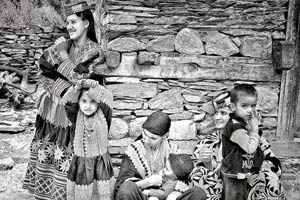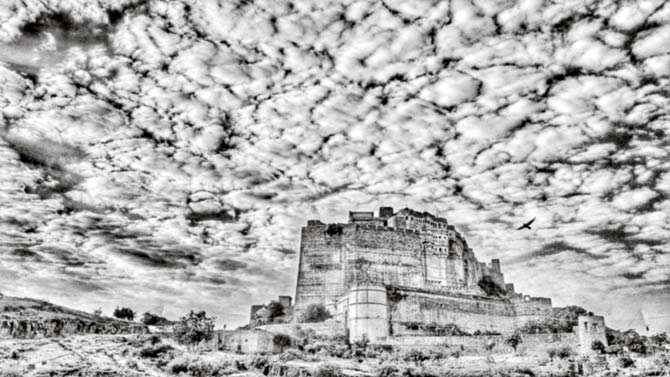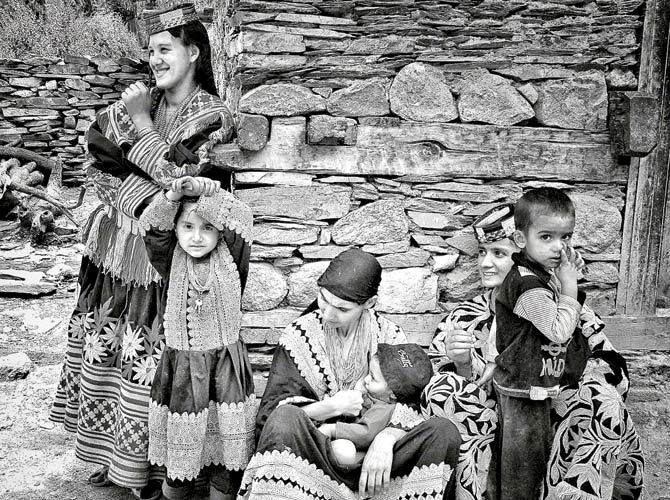Renowned author William Dalrymple's second outing as a photographer champions mobile phone photography


Early morning, Mehrangarh Fort, Jodhpur II. Pics/Tasveer© William Dalrymple
ADVERTISEMENT
There was little doubt that the people gathered for the preview of The Historian's Eye were there to hear their favourite historian speak. Whether they were there for William Dalrymple the photographer, whose latest, and second series of works is on view, remains to be seen.

Kalash women, Chitral, Pakistan
The Historian's Eye, presented by Tasveer and Dauble, is a series of 40 monochrome works, all shot by Dalrymple between 2015 and 2017 as part of his research for his upcoming book, The Anarchy. The book follows the footsteps of Shah Alam and his reign over a fading Mughal Empire in the face of the growing prowess of the East India Company.
Dalrymple has attempted to convey the elegiac tone through his photographs, spanning Murshidabad in West Bengal to Chitral in Pakistan. Ruins, aerial roots clinging on to walls like the scent of death, and untouched wildernesses are sought out to portray the twilight of the Mughal Era. The manner in which the present interacts with the past - a madrasa functioning out of the remains of Tipu Sultan's Great Mosque in Srirangapatnam or a chai boy running through the arches of Lahore's Shalimar Gardens - is what history is all about, one could argue.
What's commendable is that these photographs were shot on a Samsung Edge phone, converted into black and white, and edited on Snapseed. Considering that the prints start at R40,000, here is a giant leap for mobile phone photography, a craft for which there are but few serious takers in India. Let's hope more galleries take the guerrilla art as seriously as they have in this case, and not wait for mobile phone photographers to publish 10 books before they can have an exhibition.
That said, some works suffer from over-editing - case in point, the ominous HDR clouds looming over Mehrangarh Fort. The usual side-effects of editing are prominent in landscapes, where the image has been blown-up. Dalrymple tells us that this series is more focused than his 2016 debut, The Writer's Eye. The portraits are impressive. We particularly loved one ofwomen and children of the Kalash tribe. Then there is a pairing of photographs shot at The Marble Palace in Kolkata - the royal head of a 'British' lion opposed with the back of a callipygian sculpture.
The photographs of Durga Puja in Bengal are the kinds that audiences have been over-exposed to, and make you wonder what's the story that Dalrymple wishes to tell. The Historian's Eye gains strength from his words, be it through his essay and captions that contextualise the photos, which unfortunately will not be available until Tasveer and Dauble publish the book later this year). Without these references, you could well be looking at just another travel photography suite. The Historian's Eye is missing precisely this - the historian's words as the photographs don't tell you the full story, and, perhaps, don't intend to. We have seen the writer's eye and the historian's eye, but we are yet to see Dalrymple's unfiltered photographic eye.
Where: Akara Art, Colaba
When: Till May 3, 11 am-6.30 pm
Call: 22025550
Catch up on all the latest Mumbai news, crime news, current affairs, and also a complete guide on Mumbai from food to things to do and events across the city here. Also download the new mid-day Android and iOS apps to get latest updates
 Subscribe today by clicking the link and stay updated with the latest news!" Click here!
Subscribe today by clicking the link and stay updated with the latest news!" Click here!







